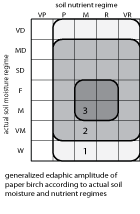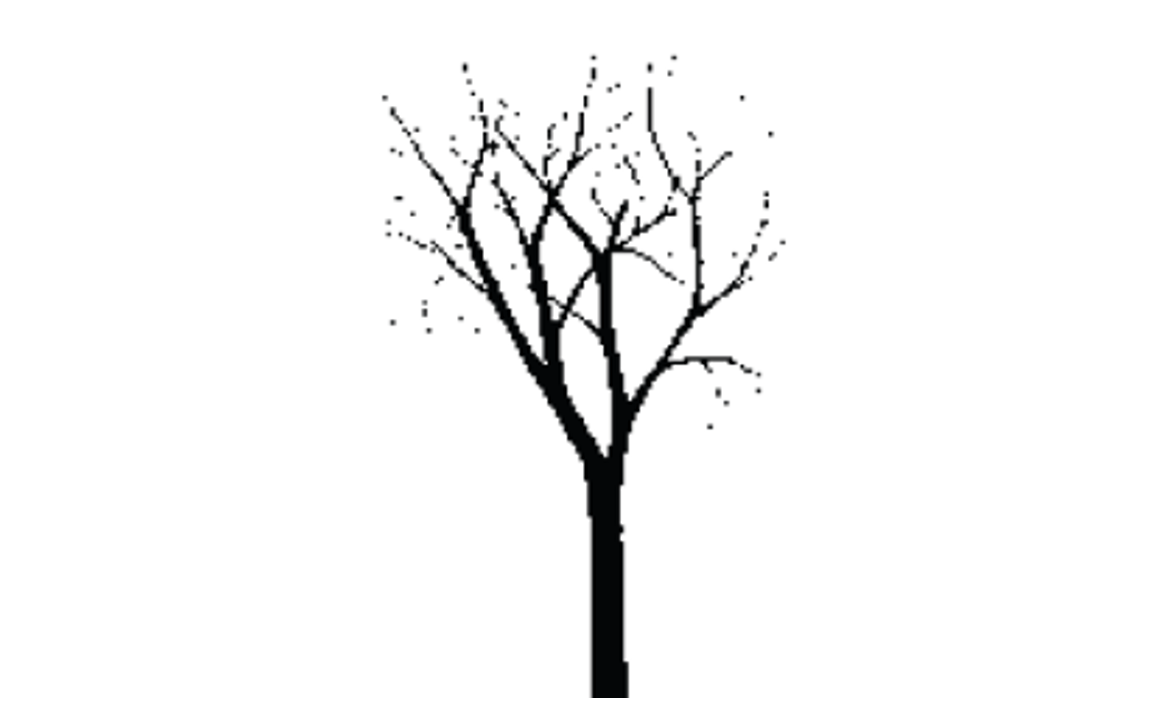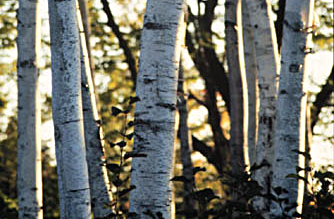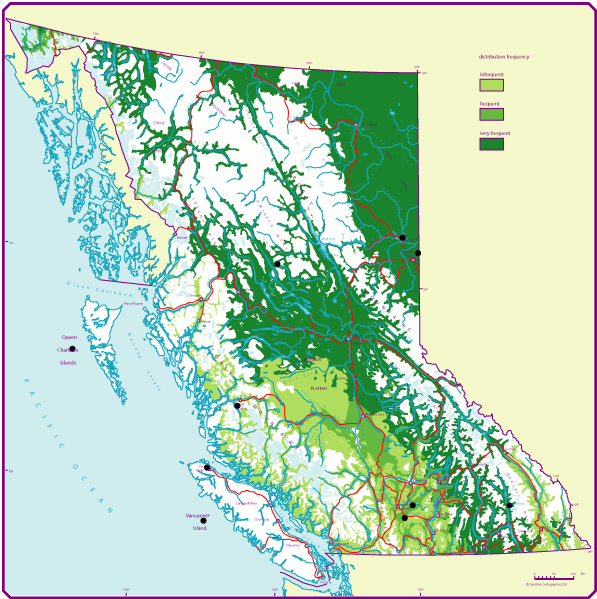Paper birch
On this page
- Geographic range and ecological amplitudes
- Tolerances and damaging agents
- Silvical characteristics
- Genetics and notes
Geographic range and ecological amplitudes
Description
Paper birch is a medium-sized (<40m tall), deciduous broad-leaved tree, at maturity with a narrowly oval, open crown, ascending branches, slender, often curved, stem, and papery bark, with irregular, rough sections. Its wood is used for veneer, pulp, and many specialty products. It is an important browse tree — its seed, buds, and bark are eaten by wildlife.
Geographic range
Geographic element:
North American transcontinental-incomplete
Distribution in Western North America:
(north and central) in the Pacific region; north, central, and (south) in the Cordilleran region
Ecological amplitudes
Climatic amplitude:
subarctic - (subalpine boreal) - montane boreal
Orographic amplitude:
montane - (subalpine)
Occurrence in biogeoclimatic zones:
(lower SWB), BWBS
Edaphic amplitude

Range of soil moisture regimes:
(fresh) - moist - very moist - wet
Range of soil nutrient regimes:
very poor - poor - medium; oxylophyte
Tolerance and damaging agents
Root system characteristics
Paper birch is generally a shallow-rooted species. The bulk of the roots are in the top 60 cm; tap roots do not develop. Roots are associated with ecto and endo-mycorrhizae.
| Tolerance to | Tolerance class | Comments |
|---|---|---|
| low light | M | probably moderately shade-tolerant |
| frost | H | frequent on sites with growing season frost |
| heat | M | in warmer climates it is infrequent on insolated sites |
| water deficit | M | infrequent on dry sites; like red alder, responds to drought by shedding its leaves |
| water surplus | H | infrequent on wet sites; tolerates flooding, and sites with a strongly fluctuating water table well |
| nutrient (mainly N) deficiency | M | absent in acid, very poor soils; a nutrient-sensitive species, responds well to fertilization |
| Damaging agent | Resistance class | Comments |
|---|---|---|
| snow | L | high snowfall will break branches rather than boles |
| wind | M | high winds will break the boles rather than uproot trees |
| Risk class | ||
|---|---|---|
| fire | M | bark is highly flammable; fire frequency is lower in pure birch stands, higher in birch-conifer mixtures |
| insect | L | not a major concern |
| fungi | L | not a major concern |
Associated tree species and successional role
In British Columbia, paper birch grows in even-aged, pure stands or mixed with shade-tolerant conifers mainly in second-growth stands. It may be a pioneer (primary succession) on fragmental sites (talus) and is present in early and intermediate (infrequently in late seral) stages of secondary succession on floodplains and upland sites; a minor component in old-growth stands on some montane boreal sites. Paper birch may invade gaps created by windthrow of climax tree species, such as white spruce and hybrid spruce on floodplains, and retain a long-term presence.
| Associated tree species |
Occurance class | Major area of occurance |
|---|---|---|
| white spruce (and hybrids) | M | mainly in montane boreal climates |
| black spruce | L | montane boreal climates |
| lodgepole pine | L | predominantly in montane boreal climates; occasionally on wet sites in southern B.C |
| subalpine fir | L | mainly in montane boreal climates |
| western hemlock | L | mainly in cool temperate climates |
| trembling aspen | L | mainly in montane boreal climates |
| common douglas | L | mainly in cool temperate climates |
| western redcedar | L | mainly in cool temperate climates |
Genetics and notes
Genetics
Paper birch has a large, very plastic gene pool. Six varieties are recognized, and hybridization with almost every other native species in the genus is very common.
Notes
Paper birch produces moderately high yields of wood in a relatively short time (60 to 80 years) compared to boreal conifers. Considering its productivity, easy regeneration, and low risk of being affected by damaging agents, it is a suitable species for intensive management on some boreal sites. Considering its wildlife and aesthetic values and soil improvement capacity, it is a useful short-term or even a long-term admixture in coniferous stands [for example, white spruce or hybrid (interior) spruce] throughout the BWBS and SBS zones. More detailed silvics information is given by:
Safford, L.O., J.C. Bjorkbom, and J.C. Zasada. 1990. Betula papyrifera. Pp. 158-171 in R.M. Burns and B.H. Honkala (technical coordinators) Silvics of North America, Vol 2. Agri. Handbook 654, USDA For. Serv., Washington, D.C.

This is the general shape and outline of the paper birch.

In B.C., paper birch grows mostly as a minor species in the montane boreal forest. This picture shows the typical growth form of paper birch. Paper birch is found all over North America.

